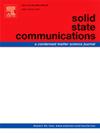揭示铜氧化物比热中的对子激发和反铁磁贡献
IF 2.1
4区 物理与天体物理
Q3 PHYSICS, CONDENSED MATTER
引用次数: 0
摘要
热测量(如熵和比热)揭示了了解铜氧化物的关键基本激元。在本文中,我们研究了三种不同化合物 La2-xSrxCuO4、Bi2Sr2CaCu2O8+δ 和 YBa2Cu3O7-δ 的比热测量结果,结果表明这些数据与 "对子 "及其激发相一致。临界温度 Tc 以上的激发涉及两个温度标度:与配对子激发有关的伪缺口 T∗ 和磁相关温度 Tmax,它们与载流子密度 (p) 的依赖关系截然不同。与我们之前对 χ(T)的分析一致,Tmax(p) 线并不是电子态密度间隙的标志,而是在低载流子浓度下占主导地位的强局部反铁磁关联的温度标度。我们的结果与 Tallon 和 Storey(2023 年)的模型截然相反,他们重申了与 T 无关的间隙 Eg 的观点,其温标 Tg=Eg/kB 随 p 线性下降,并在临界值 pc∼0 时消失。19.最后,我们讨论了 Tc 以上的非常规波动机制,它与对子激发光谱中的小间隙 δ∼ 2 meV 有关。这一能级是凝结机制的基础。本文章由计算机程序翻译,如有差异,请以英文原文为准。
Unraveling pairon excitations and the antiferromagnetic contributions in the cuprate specific heat
Thermal measurements, such as entropy and specific heat, reveal key elementary excitations for understanding the cuprates. In this paper, we study the specific heat measurements on three different compounds LaSrCuO, BiSrCaCuO and YBaCuO and show that the data are compatible with ‘pairons’ and their excitations. However, the precise fits require the contribution of the antiferromagnetic entropy deduced from the magnetic susceptibility .
Two temperature scales are involved in the excitations above the critical temperature : the pseudogap , related to pairon excitations, and the magnetic correlation temperature, , having very different dependencies on the carrier density (). In agreement with our previous analysis of , the line is not the signature of a gap in the electronic density of states, but is rather the temperature scale of strong local antiferromagnetic correlations which dominate for low carrier concentration. These correlations progressively evolve into paramagnetic fluctuations in the overdoped limit.
Our results are in striking contradiction with the model of Tallon and Storey (2023), who reaffirm the idea of a -independent gap , whose temperature scale decreases linearly with and vanishes at a critical value .
Finally, we discuss the unconventional fluctuation regime above , which is associated with a mini-gap 2 meV in the pairon excitation spectrum. This energy scale is fundamental to the condensation mechanism.
求助全文
通过发布文献求助,成功后即可免费获取论文全文。
去求助
来源期刊

Solid State Communications
物理-物理:凝聚态物理
CiteScore
3.40
自引率
4.80%
发文量
287
审稿时长
51 days
期刊介绍:
Solid State Communications is an international medium for the publication of short communications and original research articles on significant developments in condensed matter science, giving scientists immediate access to important, recently completed work. The journal publishes original experimental and theoretical research on the physical and chemical properties of solids and other condensed systems and also on their preparation. The submission of manuscripts reporting research on the basic physics of materials science and devices, as well as of state-of-the-art microstructures and nanostructures, is encouraged.
A coherent quantitative treatment emphasizing new physics is expected rather than a simple accumulation of experimental data. Consistent with these aims, the short communications should be kept concise and short, usually not longer than six printed pages. The number of figures and tables should also be kept to a minimum. Solid State Communications now also welcomes original research articles without length restrictions.
The Fast-Track section of Solid State Communications is the venue for very rapid publication of short communications on significant developments in condensed matter science. The goal is to offer the broad condensed matter community quick and immediate access to publish recently completed papers in research areas that are rapidly evolving and in which there are developments with great potential impact.
 求助内容:
求助内容: 应助结果提醒方式:
应助结果提醒方式:


